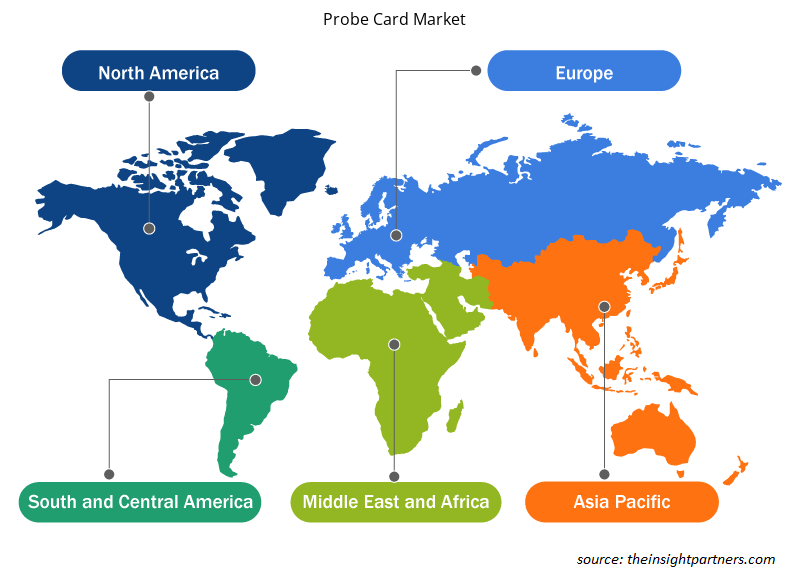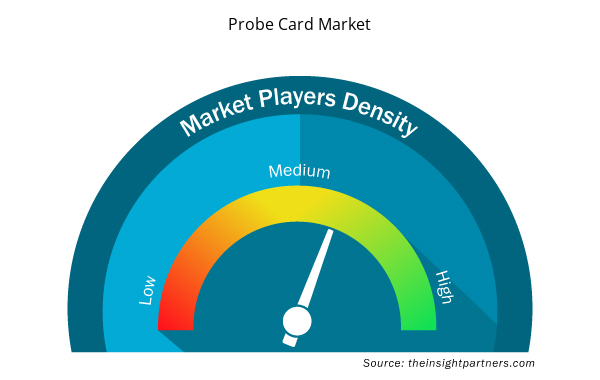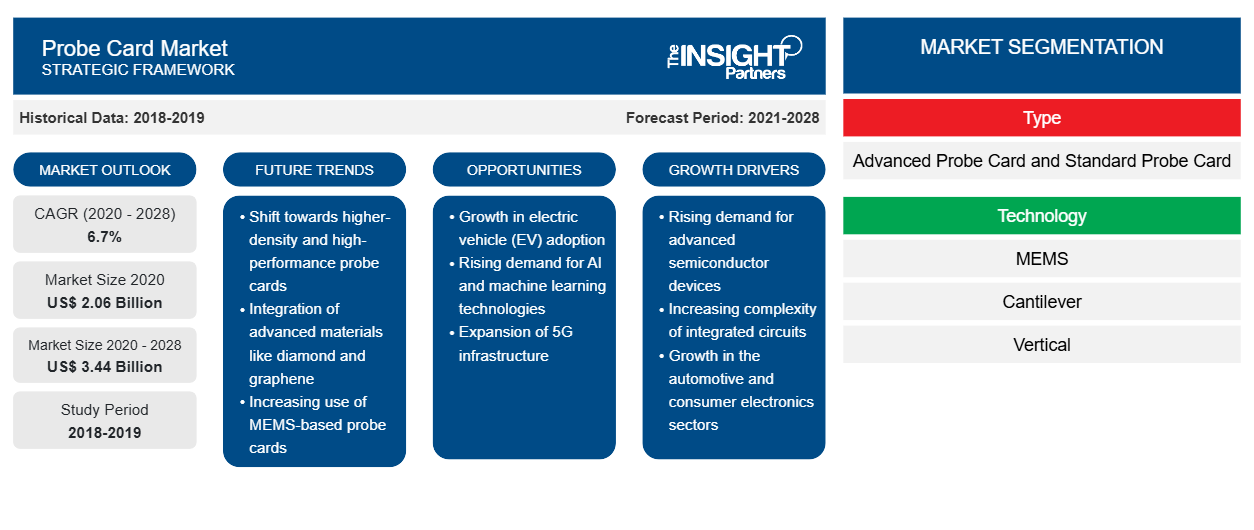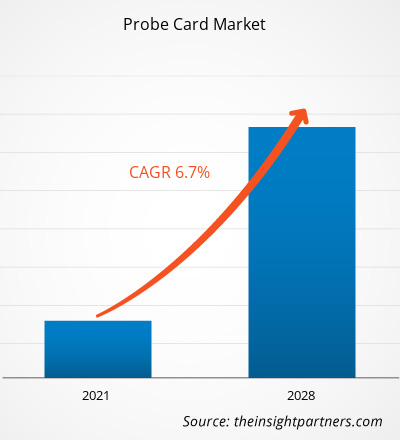探针卡市场规模预计将从 2020 年的 20.598 亿美元增至 2028 年的 34.368 亿美元;预计在 2021-2028 年期间市场将实现 6.7% 的复合年增长率。
探针卡是一种用于测试半导体晶圆的接口。在半导体制造的初始步骤中,此过程用于评估集成电路或潜在语义索引的质量。在大多数情况下,探针卡以机械方式对接在探测器上,并以电气方式连接到测试器。探针卡的主要目的是在测试设备和晶圆上的电路之间建立电气连接,以便测试电路。印刷电路板 (PCB) 和各种类型的接触元件是探针卡的基本组件。探针卡考虑了各种元件,其中一些非常常见,而另一些则具有高度特定的用途。
消费电子行业的发展得益于手机、台式机、数码相机、平板电脑、笔记本电脑、硬盘和电视等的使用增加,以及新技术的不断研究和引进。智能设备和物联网的引入,以及平板电脑的普及和对大屏幕设备的需求激增,都促进了探针市场的增长。芯片尺寸趋势的变化和对各种电子产品中创意架构的日益偏好推动了对半导体的需求。IC 芯片制造规模的扩大导致对电子测试的需求激增,这推动了对探针卡的需求。将人工智能和物联网等现代技术融入半导体生产设备将加速它们在制造设施中的接受度。此外,物联网设备对硅基传感器的需求增加、芯片行业在新兴国家的扩张以及数据中心和服务器数量的增加都是有助于提高半导体行业性能的因素,进而促进了对探针卡的需求。
为了最大限度地减少病毒传播而实施的全球封锁严重扰乱了供应链活动以及多家制造商(尤其是中小企业主)的生产量。由于工业部门和最终用户对电子元件的需求下降,半导体行业受到重创。由于封锁期间没有进行大规模生产,微电子的收入模式已经下降。封锁结束后,随着生产设施采取社交距离措施重启运营,半导体行业开始重新夺回市场份额。此外,在家办公和远程监控策略也有助于提高先进电子产品的销量,从而实现更好的连接。IT 和电信行业在通信方面的重要性得到了强调,这使得该行业能够随着物联网连接和高速 Wi-Fi 兼容封装技术等新技术的发展而发展。
定制此报告以满足您的需求
您可以免费定制任何报告,包括本报告的部分内容、国家级分析、Excel 数据包,以及为初创企业和大学提供优惠和折扣
- 获取此报告的关键市场趋势。这个免费样品将包括数据分析,从市场趋势到估计和预测。
根据探针卡市场报告,预计亚太地区将占据全球探针卡市场的大部分份额。亚太地区包括中国、印度、日本、澳大利亚和韩国等最大和最具活力的经济体。台湾、中国和日本是亚太地区领先的半导体制造国。印度和中国等发展中国家的可支配收入不断增加,为智能可穿戴设备、智能手机和电动汽车等高科技消费电子产品带来了庞大的客户群。这一因素预计将推动该地区的探针卡市场。中国是 IC 封装技术产品的主要制造中心,而台湾、韩国和日本也是区域市场增长的重要贡献者。许多亚太国家都以大规模生产消费电子、汽车零部件、电信设备和其他工业机械所需的电子设备为特征。由于拥有大量熟练的人力资源,印度和中国的电子制造公司数量不断增加,推动了探针卡市场的增长。
探针卡市场细分
根据探针卡市场分析,市场分为类型、技术、应用和地理区域。根据类型,探针卡市场分为高级探针卡和标准探针卡。根据技术,探针卡市场分为 MEMS、悬臂和垂直。根据应用,探针卡市场分为代工厂和逻辑、DRAM、闪存和其他。地理分析基于北美、欧洲、亚太地区 (APAC) 和世界其他地区 (RoW) 等地区进行。
一些主要的探针卡市场参与者包括 FEINMETALL GmbH、FormFactor、富士通、GGB Industries、日本电子材料公司、韩国仪器有限公司、Micronics Japan Co., Ltd.、MPI Corporation、SV Probe 和 Technoprobe SpA
基于类型的探针卡市场洞察
根据类型,全球探针卡市场分为高级探针卡和标准探针卡。探针卡是一种接口,或用于对半导体晶圆进行晶圆测试的电路板。使用探针卡进行的测试基本上有三种:直流测试、交流测试和功能测试。
探针卡市场区域洞察
Insight Partners 的分析师已详尽解释了预测期内影响探针卡市场的区域趋势和因素。本节还讨论了北美、欧洲、亚太地区、中东和非洲以及南美和中美洲的探针卡市场细分和地理位置。

- 获取探针卡市场的区域特定数据
探针卡市场报告范围
| 报告属性 | 细节 |
|---|---|
| 2020 年市场规模 | 20.6亿美元 |
| 2028 年市场规模 | 34.4 亿美元 |
| 全球复合年增长率(2020 - 2028) | 6.7% |
| 史料 | 2018-2019 |
| 预测期 | 2021-2028 |
| 涵盖的领域 | 按类型
|
| 覆盖地区和国家 | 北美
|
| 市场领导者和主要公司简介 |
|
市场参与者密度:了解其对商业动态的影响
探针卡市场正在快速增长,这得益于终端用户需求的不断增长,而这些需求又源于消费者偏好的不断变化、技术进步以及对产品优势的认识不断提高等因素。随着需求的增加,企业正在扩大其产品范围,进行创新以满足消费者的需求,并利用新兴趋势,从而进一步推动市场增长。
市场参与者密度是指在特定市场或行业内运营的企业或公司的分布情况。它表明在给定市场空间中,相对于其规模或总市场价值,有多少竞争对手(市场参与者)存在。
探针卡市场的主要运营公司有:
- FEINMETALL 有限公司
- FormFactor 公司
- 富士通
- GGB工业
- 日本电子材料株式会社
免责声明:上面列出的公司没有按照任何特定顺序排列。

- 获取探针卡市场顶级关键参与者的概览
探针卡市场报告中介绍的参与者主要专注于开发先进高效的产品。探针卡市场公司正在实施各种战略以配合探针卡市场的技术进步。
- 2020 年,FormFactor 宣布推出面向新兴计算应用的低温探针系列。
- 2020 年,Technoprobe 收购了 Microfabrica。
- 历史分析(2 年)、基准年、预测(7 年)及复合年增长率
- PEST 和 SWOT 分析
- 市场规模价值/数量 - 全球、区域、国家
- 行业和竞争格局
- Excel 数据集



Report Coverage
Revenue forecast, Company Analysis, Industry landscape, Growth factors, and Trends

Segment Covered
This text is related
to segments covered.

Regional Scope
North America, Europe, Asia Pacific, Middle East & Africa, South & Central America

Country Scope
This text is related
to country scope.
常见问题
Increasing penetration of consumer electronics and rise in manufacturing of semiconductor chips due to proliferating automotive sector are driving the growth of the global probe card market.
On the basis of type segment, the probe card market is segmented into advanced probe card and standard probe card. The advanced probe card segment led the global probe card market with a market share of 77.5% in 2020. Further, it is expected to garner 80.2% share by 2028.
APAC led the market with a highest revenue share in 2020, and it is also expected to register the fastest CAGR during the forecast period. China, Japan, and South Korea are among the major contributors to the probe card market growth in APAC. The electronics industries in China and Japan represent huge potential for the manufacturing and sale of probe card devices. Similarly, many APAC countries are characterized by the mass production of electronic components required for consumer electronics, automotive devices, telecommunication devices, and other industrial machinery. Rising number of electronics manufacturing companies in India and China owing to the availability of skilled human resources is driving the probe card market growth. The growing production of ICs in APAC is also another factor driving the probe card market growth.
Trends and growth analysis reports related to Electronics and Semiconductor : READ MORE..
The List of Companies - Probe Card Market
- FEINMETALL GmbH
- FormFactor, Inc.
- Fujitsu
- GGB Industries
- Japan Electronic Materials Corporation
- Korea Instrument Co., Ltd.
- MPI Corporation
- SV Probe
- Technoprobe S.p.A.
- Micronics Japan Co., Ltd.
The Insight Partners performs research in 4 major stages: Data Collection & Secondary Research, Primary Research, Data Analysis and Data Triangulation & Final Review.
- Data Collection and Secondary Research:
As a market research and consulting firm operating from a decade, we have published and advised several client across the globe. First step for any study will start with an assessment of currently available data and insights from existing reports. Further, historical and current market information is collected from Investor Presentations, Annual Reports, SEC Filings, etc., and other information related to company’s performance and market positioning are gathered from Paid Databases (Factiva, Hoovers, and Reuters) and various other publications available in public domain.
Several associations trade associates, technical forums, institutes, societies and organization are accessed to gain technical as well as market related insights through their publications such as research papers, blogs and press releases related to the studies are referred to get cues about the market. Further, white papers, journals, magazines, and other news articles published in last 3 years are scrutinized and analyzed to understand the current market trends.
- Primary Research:
The primarily interview analysis comprise of data obtained from industry participants interview and answers to survey questions gathered by in-house primary team.
For primary research, interviews are conducted with industry experts/CEOs/Marketing Managers/VPs/Subject Matter Experts from both demand and supply side to get a 360-degree view of the market. The primary team conducts several interviews based on the complexity of the markets to understand the various market trends and dynamics which makes research more credible and precise.
A typical research interview fulfils the following functions:
- Provides first-hand information on the market size, market trends, growth trends, competitive landscape, and outlook
- Validates and strengthens in-house secondary research findings
- Develops the analysis team’s expertise and market understanding
Primary research involves email interactions and telephone interviews for each market, category, segment, and sub-segment across geographies. The participants who typically take part in such a process include, but are not limited to:
- Industry participants: VPs, business development managers, market intelligence managers and national sales managers
- Outside experts: Valuation experts, research analysts and key opinion leaders specializing in the electronics and semiconductor industry.
Below is the breakup of our primary respondents by company, designation, and region:

Once we receive the confirmation from primary research sources or primary respondents, we finalize the base year market estimation and forecast the data as per the macroeconomic and microeconomic factors assessed during data collection.
- Data Analysis:
Once data is validated through both secondary as well as primary respondents, we finalize the market estimations by hypothesis formulation and factor analysis at regional and country level.
- Macro-Economic Factor Analysis:
We analyse macroeconomic indicators such the gross domestic product (GDP), increase in the demand for goods and services across industries, technological advancement, regional economic growth, governmental policies, the influence of COVID-19, PEST analysis, and other aspects. This analysis aids in setting benchmarks for various nations/regions and approximating market splits. Additionally, the general trend of the aforementioned components aid in determining the market's development possibilities.
- Country Level Data:
Various factors that are especially aligned to the country are taken into account to determine the market size for a certain area and country, including the presence of vendors, such as headquarters and offices, the country's GDP, demand patterns, and industry growth. To comprehend the market dynamics for the nation, a number of growth variables, inhibitors, application areas, and current market trends are researched. The aforementioned elements aid in determining the country's overall market's growth potential.
- Company Profile:
The “Table of Contents” is formulated by listing and analyzing more than 25 - 30 companies operating in the market ecosystem across geographies. However, we profile only 10 companies as a standard practice in our syndicate reports. These 10 companies comprise leading, emerging, and regional players. Nonetheless, our analysis is not restricted to the 10 listed companies, we also analyze other companies present in the market to develop a holistic view and understand the prevailing trends. The “Company Profiles” section in the report covers key facts, business description, products & services, financial information, SWOT analysis, and key developments. The financial information presented is extracted from the annual reports and official documents of the publicly listed companies. Upon collecting the information for the sections of respective companies, we verify them via various primary sources and then compile the data in respective company profiles. The company level information helps us in deriving the base number as well as in forecasting the market size.
- Developing Base Number:
Aggregation of sales statistics (2020-2022) and macro-economic factor, and other secondary and primary research insights are utilized to arrive at base number and related market shares for 2022. The data gaps are identified in this step and relevant market data is analyzed, collected from paid primary interviews or databases. On finalizing the base year market size, forecasts are developed on the basis of macro-economic, industry and market growth factors and company level analysis.
- Data Triangulation and Final Review:
The market findings and base year market size calculations are validated from supply as well as demand side. Demand side validations are based on macro-economic factor analysis and benchmarks for respective regions and countries. In case of supply side validations, revenues of major companies are estimated (in case not available) based on industry benchmark, approximate number of employees, product portfolio, and primary interviews revenues are gathered. Further revenue from target product/service segment is assessed to avoid overshooting of market statistics. In case of heavy deviations between supply and demand side values, all thes steps are repeated to achieve synchronization.
We follow an iterative model, wherein we share our research findings with Subject Matter Experts (SME’s) and Key Opinion Leaders (KOLs) until consensus view of the market is not formulated – this model negates any drastic deviation in the opinions of experts. Only validated and universally acceptable research findings are quoted in our reports.
We have important check points that we use to validate our research findings – which we call – data triangulation, where we validate the information, we generate from secondary sources with primary interviews and then we re-validate with our internal data bases and Subject matter experts. This comprehensive model enables us to deliver high quality, reliable data in shortest possible time.


 获取此报告的免费样本
获取此报告的免费样本